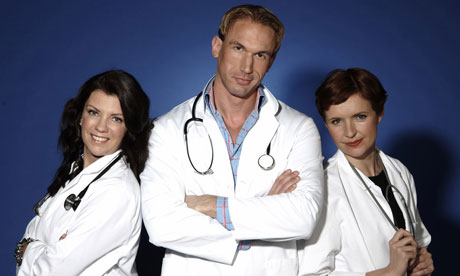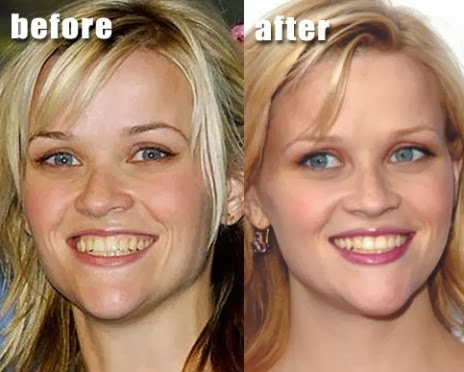Don’t be shy over our Embarrassing Bodies issues? says a TV doctor
Dr Pixie McKenna says Irish still reluctant to confront sensitive complaints.
“The Irish are a little bit like ‘We have to wait for something to drop off before we come to surgery’,” said Dr Pixie McKenna of Channel 4’s Embarrassing Bodies. Dr McKenna grew up in Glasheen in Cork and obtained her medical degree from University College Cork.
Irish people need to overcome their shyness about embarrassing health issues and be more willing to visit doctors to discuss their health, according to Dr Pixie McKenna of Channel 4’s Embarrassing Bodies.
Dr McKenna, a co-presenter on the programme, said the Irish seemed particularly reluctant to discuss health matters, a situation which could often have serious consequences.
“The Irish are a little bit like ‘We have to wait for something to drop off before we come to surgery’,” said Dr McKenna, who grew up in Glasheen in Cork and obtained her medical degree from University College Cork.
Dr McKenna, who moved to the UK in 1999 and worked as a GP in Notting Hill in London, said she believed the Irish are much more shy when it comes to discuss embarrassing health conditions compared to British, American or Australian patients.
“One of our mantras on the show is ‘Don’t die of embarrassment’. We mean that in every sense. Testicular cancer, colon cancer, breast cancer, skin cancer…they may have embarrassing symptoms, but you cannot afford to waste time by sitting and hoping they get better.
“The truth is you may not survive it,” said Dr McKenna, who was in Cork to help launch the Mercy Hospital Foundation campaign to raise €3 million to enhance cardiology, stroke and cancer services at the Mercy University Hospital.
Dr McKenna said she was delighted to lend her support to the campaign as she had fond memories of Mercy University Hospital, where she did some of her training. Each of the areas the foundation was focusing on was deserving of support, she added.
“I’m urging the people of Cork and of Munster to dig deep and support any or all of the appeals over the coming years – you never know when you could be affected and may need the services in your own family.”
Very silly to search blind for the missing jet,
INSISTS THE MAN WHO FOUND TITANIC
The man who discovered the wreck of the Titanic says searching for the missing Malaysian Airways plane is a waste of time?
Dr Robert Ballard was speaking yesterday at the opening of the new Ocean Exploration Centre at Titanic Belfast.
One of the world’s best known acquatic explorers, he was the guest of honour at the opening of the new exhibit two years after the centre opened.
He said it was among the most sophisticated he had seen anywhere in the world.
“It adds to the visitor experience at Titanic Belfast and adds to the legacy of Titanic,” he said.
“Indeed, it is a product of Titanic’s legacy; that great ship continues to educate us to this day and will continue to inspire our learning.”
In 1985 Dr Ballard discovered the wreck of the liner more than 70 years after the ship sank on its maiden voyage.
But he was far from optimistic for those now involved in another high-profile sea hunt.
Yesterday he claimed that with no real idea of where the Malaysian Airways airliner that went missing earlier this month went down, it was “silly” to go looking for it.
He said that he had an area of just 100sq miles in which he knew Titanic lay – which is vastly more specific than the 7.7 million sq km area currently being searched for the missing plane.
“The Earth is as complicated underwater as it is above water. Is it in a mountain range? That’s a different strategy. Is it in a flat area or canyon? Every day it goes somewhere else.
“On the news this morning a satellite saw wreckage off Perth, Australia.
“So now suddenly it’s off Perth?”
Dr Ballard said he thought the wreckage will eventually wash up on a beach.
“I would imagine in years people are going to be walking on a beach and they will pick up something, because a lot of that eventually comes to shore,” he said.
“Then you realise where it is.
“It’s silly to go looking. The problem is that the transponder (black box) is going to run out of power, so it’s a ticking clock of 30 days. And wreckage doesn’t float indefinitely, so that’s another problem.
“After 30 days the battery runs out, but to hear it you have to go close enough to hear it, within 10 miles, and you have to have the right listening device to hear it.
“My ship will be there in two or three years. I would hope it is done before that.
“When I found Titanic, the search area was reasonable, it was 10 miles by 10 miles. Even that was 100 square miles. You need a box around that size.
“It’s dark down there. It shows you the frontiers still to be explored.”
BACKGROUND
Titanic Belfast has launched a new Ocean Exploration Centre which has been lauded as one of the most sophisticated in the world.
The new centre boasts a timeline of ocean exploration, control room of a research vessel, and computer game style look underneath the seas around Ireland.
It will also include a link to Dr Robert Ballard’s exploration vessel E/V Nautilus as it starts a new mission off the coast of Florida in June.
Depression is a BIG barrier to quitting cigarettes


Patients who have heart disease are much less likely to quit smoking than their non-depressed counterparts, according to new research.
A new study presented at the Royal College of Surgeons in Ireland Research Day has highlighted the need for smoking cessation therapy in cardiac patients.
Quitting smoking is regarded as a crucial step in helping recovery after a heart attack, resulting in a 50% better chance of of survival.
Lead author of the study, Dr Frank Doyle of the College’s Department of Psychology, said giving up smoking is the most important change that patients with heart disease can make to improve their prognosis.
“We have found that patients with depressive symptoms are less likely to give up smoking in the short and long term, with the majority having taken up smoking again after one year.”
He said the research highlights the need for GPs both to treat depression in heart patients and to help them in smoking cessation.
Dr Doyle said it has been shown that patients who have had a heart attack and are depressed are at considerably increased risk of having a further heart attack or dying within a relatively short period compared to heart patients who are not depressed.
He said smoking may well be a factor in this.
“Smokers with heart disease may require aggressive depression treatment to enhance their chances of quitting. It is important that GPs provide treatment for symptoms of depression to coronary heart disease patuents on an ongoing basis,” Dr Doyle said.
Ireland 2nd has an exceptionally high rate of suicide says Euro report


THE TOP TEN COUNTRIES IN THE EURO STUDY.
(1) Lithuania 5.12, (2nd) Ireland 4.48, (3) Finland 4.08, (4) Slovenia 3.99, (5) Estonia 3.89, (6) Poland 3.31, (7) Latvia 3.16, (8) Norway 2.82, (9) Romania 2.7, (10) Austria 2.71.
The report uses suicide data as an indicator to measure levels of violence against children
Ireland has exceptionally high rates of suicide among young males and females but lacks a national strategy on prevention, a Europe-wide report on injuries sustained by children as a result of violence has found.
The report is the first to comprehensively assess national strategies that address child intentional injury across the EU. It examines child maltreatment, peer violence and self-directed violence which are regarded as the three main areas of violence against children.
The European Child Safety Alliance report found that despite the high suicide rate here, Ireland does not have a national strategy for the prevention of suicide and self-directed injury.
It also highlights the absence of laws mandating reporting of suspected cases of child maltreatment by professionals and the absence of laws prohibiting corporal punishment in all settings.
Dr Anthony Staines, chair of health systems at DCU’s School of Nursing and Human
Sciences said Ireland has “a very serious problem with suicide.”
Dr Staines said Ireland does not have “a full range of measures in place to minimise intentional injury in childhood, though we are better in this respect than many other countries.”
“Intentional injury in childhood is often a hidden problem and needs much more attention from Irish and European societies,” he said.
Of the more than 35,000 children and adolescents aged 0-19 years who die each year in the EU, about 24 per cent or roughly 9,100 deaths are due to injuries. Of these, about a third are classified as intentional or of undetermined intent.
There were 600 deaths of people under the age of 25 recorded in Ireland in 2012. Of these, 195 of were due to external causes, 101 were accidental and 94 were intentional or unknown (mostly suicide).
The report found that Ireland has the highest rate of suicide in young females across Europe and the second highest rate of suicide in young males.
At 5.12 male deaths per 100,000 of children aged 0-19, Ireland had the second highest rate of suicide across Europe. Lithuania had the highest incidence of male suicide at 6.58 boys per 100,000. This compares to a EU 28 average of 2.39.
Ireland had the highest rate of female suicide across the surveyed countries at 2.09 per 100, 000. This compares to an average across 28 EU countries of 0.84 and is 19 times greater than the lowest rate of 0.11 in Greece*.
The figures used in the study are based on data from the World Health Organisation’s European detailed mortality database from 2009 to 2011.
Ireland compares well with other countries in some policy areas and is one of only four countries to have either a national programme of multi-disciplinary child death reviews or regional programmes across the whole country in place.
Ireland also had the lowest rate of child homicide per 100,000 aged 0-19 years at 0.11 in boys and 0.27 in girls. This compares to an average of 0.44 in boys and 0.36 in girls across the EU28 plus Norway.
In general, the report finds that the resources put toward combating child intentional injury do not take account of the magnitude of the issue, considering the life-long impact that violence can have on children.
It calls for improved leadership to make intentional injury prevention a priority; better provision of detailed mortality data and the introduction of national coordinating frameworks and plans to prevent intentional child injury.
“It is clear that preventing intentional injuries is an investment that will save money both now and in the future and efforts must be made to ensure investment are at minimum maintained, if not increased, during the current economic crisis. The decisions made today will ultimately affect future generations of Europeans,” the report says.
Obesity associated with lower academic attainment in
OUR TEENAGE GIRLS


Girls who were obese, as measured by BMI at age 11 had lower academic attainment at 11, 13 and 16 years when compared to those of a healthy weight….
The research conducted by the Universities of Strathclyde, Dundee, Georgia and Bristol is the most comprehensive study yet carried out into the association between obesity and academic attainment in adolescence.
The results showed that girls who were obese, as measured by BMI (body mass index) at age 11 had lower academic attainment at 11, 13 and 16 years when compared to those of a healthy weight. The study took into account possible mediating factors but found that these did not affect the overall results. Attainment in the core subjects of English, Maths and Science for obese girls was lower by an amount equivalent to a D instead of a C, which was the average in the sample. Associations between obesity and academic attainment were less clear in boys.
University of Strathclyde Professor of Physical Activity and Public Health Science, John Reilly – the Principal Investigator of the study – said: “Further work is needed to understand why obesity is negatively related to academic attainment, but it is clear that teenagers, parents, and policymakers in education and public health should be aware of the lifelong educational and economic impact of obesity.”
Dr Josie Booth, of the School of Psychology at the University of Dundee, said: “There is a clear pattern which shows that girls who are in the obese range are performing more poorly than their counterparts in the healthy weight range throughout their teenage years.”
The study examined data from almost 6000 children from the Avon Longitudinal Study of Parents and Children (ALSPAC), including academic attainment assessed by national tests at 11, 13 and 16 years and weight status. 71.4% were healthy weight (1935 male, 2325 female), 13.3% overweight (372 male, 420 female) and 15.3% obese (448 male, 466 female).
The researchers took into account potentially distorting factors such as socio-economic deprivation, mental health, IQ and age of menarche (onset of the menstrual cycle) but found these did not change the relationship between obesity and academic attainment.
DNA left at crime scenes could be used to create mugshots to help catch criminals


DNA left at a crime scene could in future be used to build up a picture of an offender’s face leading to the culprit being caught.
DNA left at a crime scene could in future be used to build up a picture of an offender’s face, scientists believe.
A first step towards genetic mugshots — a sci-fi twist on the hit TV series CSI: Crime Scene Investigation — has been taken by US researchers linking specific DNA markers with face shape.
To identify the genes, they focused on known mutations that cause deformations of the face and head.
Normal versions of these genes were found to influence individual features. For instance, one gene affected the lips, another the shape and configuration of bones around the eyes, and a third the appearance of the mid-face and skull.
In total, 20 genes had “significant effects” on facial appearance.
“We use DNA to match to an individual or identify an individual, but you can get so much more from DNA,” lead scientist Professor Mark Shriver, from Pennsylvania State University, said.
“Currently we can’t go from DNA to a face, or from a face to DNA, but it should be possible.”
The implications are far reaching, raising the possibility of creating a data bank of facial types based on genetic markers.
DNA from a crime scene could then be used to produce a rough image of the face of an offender or victim.
Such genetic mugshots may be more reliable than computer-generated “e-fits” based on witnesses’ recollections.
Other uses of the technique might include proving the identity of fathers in paternity cases, or visualising our remote ancestors from fossil DNA.
“Such predictive modelling could be forensically useful; for example, DNA left at crime scenes could be tested and faces predicted in order to help to narrow the pool of potential suspects,” the scientists wrote in the online journal Public Library of Science Genetics.
“Further, our methods could be used to predict the facial features of descendants, deceased ancestors, and even extinct human species. In addition, these methods could prove to be useful diagnostic tools.”
The team developed a model which first established a range of physical face shapes from people of mixed West African and European ancestry from the US, Brazil and Cape Verde.
Measurements were taken of thousands of point co-ordinates on grids placed over 3D images of the faces.
Statistical methods were then used to determine the relationship between facial differences and the effects of gender, ethnic ancestry and individual gene variants.




No comments:
Post a Comment